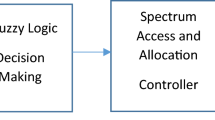Abstract
With most of the radio spectrum already allocated, cognitive radio acts as a promising solution to the spectrum scarcity problem. Increasing the secondary throughput without making interference to the primary user (PU) is a major challenge. In this paper, the secondary throughput is maximized under power constraints by obtaining an optimum value of the relay amplification factor. Comparison between using single antenna, double antennas at all the nodes of the cognitive relay network (CRN), and double antennas at the relay node only is performed. The mathematical analysis of the system is investigated for two cases: (1) The opportunistic access case, where the secondary user (SU) can transmit data only in the vacant bands of the allocated spectrum to the PU; and (2) The sensing-based spectrum sharing case, where the SU can transmit data all the time but with different transmit powers depending on the sensing information. Simulation results show that the achieved secondary throughput can be maximized at a given value of the relay amplification factor. Moreover, using double antennas at all the nodes of the CRN increases the maximum achievable throughput and improves the detection capabilities compared with using single antenna or using double antennas at the relay node only. Finally, results show that the SU can achieve more throughput under the sensing-based spectrum sharing case compared with that achieved under the opportunistic access case.







Similar content being viewed by others
References
FCC. (2003). Notice of proposed rule making and Order, ET Docket No. 03–322.
Haykin, S. (2005). Cognitive radio: Brain-empowered wireless communications. IEEE Journal on Selected Areas in Communications, 23(2), 201–220.
Akyildiz, I. F., Lee, W.-Y., Vuran, M. C., & Mohanty, S. (2006). NeXt generation/dynamic spectrum access/cognitive radio wireless networks: A survey. Computer Networks, 50(13), 2127–2159.
Yang, Li, & Nosratinia, A. (2013). Spectrum sharing with distributed relay selection and clustering. IEEE Transactions on Communications, 61(1), 53–62.
Li, C., & Li, C. (2008). Opportunistic spectrum access in cognitive radio networks. In IEEE international joint conference on, neural networks, 2008. IJCNN 2008 (IEEE World Congress on Computational Intelligence), pp. 3412–3415.
Benaya, A. M., Shokair, M., El-Rabaie, E.-S., & Elkordy, M. F. (2014). Relay-based throughput maximization in multiple antennas cognitive radio networks. In 2014 31st National, radio science conference (NRSC), pp. 116–123.
Kang, Xin, Liang, Ying-Chang, & Zhang, Lan. (2009). Sensing-based spectrum sharing in cognitive radio networks. IEEE Transactions on Vehicular Technology, 58(8), 4649–4654.
Chen, Zhong, Wang, Xiaodong, & Zhang, Xianda. (2013). Continuous power allocation strategies for sensing-based multiband spectrum sharing. IEEE Journal on Selected Areas in Communications, 31(11), 2409–2419.
Rathi, S., Dua, R. L., & Singh, P. (2011). Spectrum sensing in cognitive radio using MIMO technique. International Journal of Soft Computing and Engineering (IJSCE), 1(5), 259–265.
Partha, Pratim Bhattacharya. (2011). A survey on spectrum sensing techniques in cognitive radio. International Journal of Computer Science and Communication Networks, 1(2), 196–206.
Gavrilovska, L., & Atanasovski, V. (2011). Spectrum sensing framework for cognitive radio networks. Wireless Personal Communications, 59(3), 447–469.
Digham, F. F., Alouini, M. S., & Simon, M. K. (2007). On the energy detection of unknown signals over fading channels. IEEE Transactions on Communications, 55(1), 21–24.
Bagwari, A., & Tomar, G. S. (2013). Cooperative spectrum sensing with adaptive double threshold based energy detector in cognitive radio networks. Wireless Personal Communication. doi:10.1007/s11277-013-1244-3.
Ganesan, G., & Li, Y. (2007). Cooperative spectrum sensing in cognitive radio, Part I: Two user networks. IEEE Transactions on Wireless Communications, 6(6), 2204–2213.
Sakran, H., Shokair, M., El-Rabaie, E.-S., & El-Azm, A. A. (2011). Three bits softened decision scheme in cooperative spectrum sensing among cognitive radio networks. In 2011 28th National, radio science conference (NRSC), pp. 1–9.
Rifà-Pous, H., Blasco, M. J., & Garrigues, C. (2012). Review of robust cooperative spectrum sensing techniques for cognitive radio networks. Wireless Personal Communications, 67(2), 175–198.
Hu, H., Xu, Y., & Li, N. (2013). Optimization of time-domain combining cooperative spectrum sensing in cognitive radio networks. Wireless Personal Communications, 72(4), 2229–2249.
Sakran, H., & Shokair, M. (2011). Hard and softened combination for cooperative spectrum sensing over imperfect channels in cognitive radio networks. Telecommunication Systems, 52(1), 61–71.
Huang, Shiwei, Chen, Hongbin, & Zhang, Yan. (2012). Optimal power allocation for spectrum sensing and data transmission in cognitive relay networks. IEEE Wireless Communications Letters, 1(1), 26–29.
Author information
Authors and Affiliations
Corresponding author
Rights and permissions
About this article
Cite this article
Benaya, A.M., Shokair, M., El-Rabaie, ES. et al. Optimal Power Allocation for Sensing-Based Spectrum Sharing in MIMO Cognitive Relay Networks. Wireless Pers Commun 82, 2695–2707 (2015). https://doi.org/10.1007/s11277-015-2373-7
Published:
Issue Date:
DOI: https://doi.org/10.1007/s11277-015-2373-7




